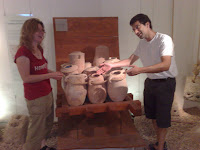 We have a number of student projects that look at novel applications and novel application platforms on mobile phones. As Michael Rohs from T-Labs is also teaching a course on mobile HCI we thought it would be a good opportunity to meet and discuss some application ideas.
We have a number of student projects that look at novel applications and novel application platforms on mobile phones. As Michael Rohs from T-Labs is also teaching a course on mobile HCI we thought it would be a good opportunity to meet and discuss some application ideas.
I gave a talk in Michael’s lecture discussing the concept of user interfaces beyond the desktop, context as enabling technology, and future applications in mobile, wearable and ubiquitous computing. We had an interesting discussion – and in the end it always comes down to privacy and impact on society. I see this as a very positive development as it shows that the students are not just techies but that they see the bigger picture – and the impact (be it good or bad) they may have with their developments. I mentioned to books that are interesting to read: the transparent society [1] and total recall [2].
 In the afternoon we discussed two specific projects. One was an application for informal social while watching TV (based on a set iconic communication elements) that can be used to generate meta data on the program shown. The other is a platform that allows web developers to create distributed mobile applications making use of all the sensors on mobile phones. It is essential a platform an API that provides access to all functions on the phones available in S60 phones over a RESTful API, e.g. you can use a HTTP call to make a photo on someone’s phone. We hope to release some of the software soon.
In the afternoon we discussed two specific projects. One was an application for informal social while watching TV (based on a set iconic communication elements) that can be used to generate meta data on the program shown. The other is a platform that allows web developers to create distributed mobile applications making use of all the sensors on mobile phones. It is essential a platform an API that provides access to all functions on the phones available in S60 phones over a RESTful API, e.g. you can use a HTTP call to make a photo on someone’s phone. We hope to release some of the software soon.
In the coffee area at T-labs was a printout with the 10+1 innovation principles – could not resist to take a photo 😉 Seems innovation is really trival – just follow the 11 rules and you are there 😉
[1] David Brin. The Transparent Society: Will Technology Force Us to Choose Between Privacy and Freedom. Basic Books. 1999. ISBN-13: 978-0738201443. Amazon-link. Webpage: http://www.davidbrin.com/transparent.htm
[2] Gordon Bell, Jim Gemmell. Total Recall: How the E-Memory Revolution Will Change Everything. Dutton Adult. 2009. ISBN-13: 978-0525951346. Amazon-link. Webpage: http://totalrecallbook.com/







